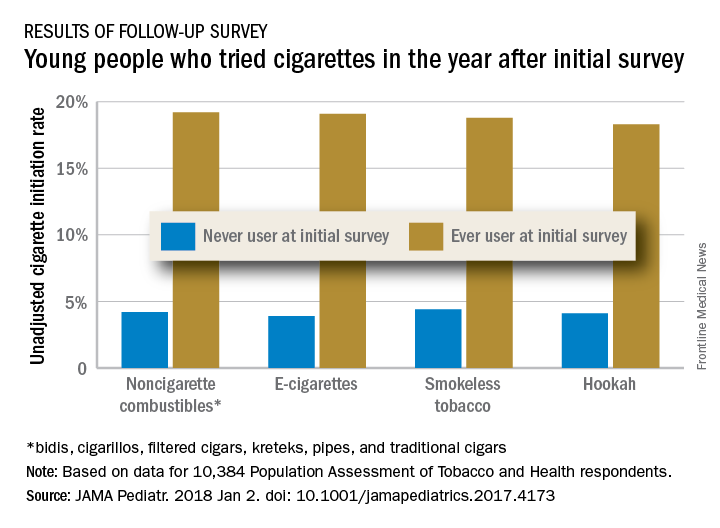Children who use noncigarette forms of tobacco are significantly more likely to try cigarettes in the future, according to survey data from over 10,000 young people aged 12-17 years.
An initial survey (wave 1) was conducted as part of the nationally representative Population Assessment of Tobacco and Health (PATH) study, with a follow-up (wave 2) administered to participants a year later. The analysis by Shannon L. Watkins, PhD, of the University of California, San Francisco, and her associates was based on data for 10,384 respondents who reported never smoking a cigarette in wave 1 and whose later cigarette use, which occurred in less than 5% overall, was reported in wave 2.
Among those who said that they had ever used an e-cigarette – the most popular of the noncigarette forms in wave 1 – 19.1% reported that they had tried a cigarette in the subsequent 12 months, compared with 3.9% who had never used an e-cigarette in wave 1. The results were similar (see graph) for the other forms of noncigarette tobacco: noncigarette combustibles (bidis, cigarillos, filtered cigars, kreteks, pipes, and traditional cigars), hookah (tobacco waterpipe), and smokeless tobacco (chewing tobacco, dissolvable tobacco, moist snuff, and snus).Those who used multiple noncigarette products were more likely than users of a single product to initiate cigarette use by wave 2. With never use of any tobacco as the reference, one model used by the investigators put the odds ratios of cigarette ever use at 4.98 for e-cigarettes only, 3.57 for combustibles only, and 8.57 for use of multiple products.
This study was supported by grants from the National Cancer Institute, Food and Drug Administration Center for Tobacco Products, National Institute on Drug Abuse, and National Center for Advancing Translational Sciences. No conflicts of interest were reported.
SOURCE: Watkins S et al. JAMA Pediatr. 2018 Jan 2. doi: 10.1001/jamapediatrics.2017.4173.


